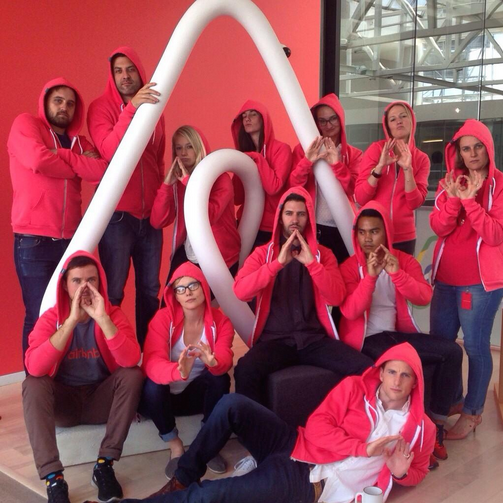“As much as this recognition sits well with me, it’s also a reflection of this institution,” said Banza Ltd. founder and Product Design alumnus Patrick Kiruki (BS 05) at the Fall 2014 graduation ceremony on December 13, as he accepted Art Center’s Alumni Award in the category of Outstanding Service. “Art Center embodies the true meaning of an education by allowing each and every student to excel in what fires them up every morning.”
Each year, Art Center presents a select group of alumni with the Art Center Alumni Award in a number of categories. This year the College awarded the Lifetime Achievement award to Transportation Design alumnus Shiro Nakamura (BS 81); the Young Alumni Innovator award to Product Design alumna Katie Dill (BS 07); and the Outstanding Service award to Kiruki.
Shiro Nakamura, Lifetime Achievement
In his introduction of Nakamura, Chair of Transportation Design Stewart Reed called the chief creative officer and senior vice president of Nissan “one of our most distinguished alumni and a real hero in the automotive design world.”
After receiving his bachelor’s degree from Musashino Art University in Tokyo, Nakamura came to Art Center in the late ’70s to focus on transportation design, and studied under a number of instructors including current faculty member Richard Pietruska, who was in the audience on Saturday. Nakamura graduated with distinction in 1981 and quickly gained recognition for his talent and his hands-on approach.
He first went to Isuzu, where he was responsible for the design of numerous vehicles, including the Via Cross and the Gemini. In 1999, Nissan’s new CEO Carlos Ghosn wooed Nakamura from Isuzu to lead the design side of Nissan’s revival. While at Nissan, Nakamura has guided the creation of iconic vehicles like the Cube, Fairlady Z, GTR, Murano, Juke and Leaf, as well as Infiniti’s M, FX and Essence.
“Shiro has also been a tremendous advocate for Art Center and for our students over the years, leading Nissan’s support of scholarships, sponsored projects, interns and hiring many of our top graduates,” added Reed. “We are very grateful for all of that.”
“Art Center is about working hard,” said Nakamura, after accepting the award. “I graduated 33 years ago, but my experience was just the same. This school pushes you to your limit, and that gave me a strong sense of confidence.”
“Today, I have received a very nice award,” he continued. “However, I do not necessarily like the name of this award, because ‘Lifetime Achievement’ sounds a bit like I am retiring. No, I have no intention to retire!”

Katie Dill (BS 07), second from right, and the Airbnb design team. Source: Twitter
Katie Dill, Young Alumni Innovator
Next, Karen Hofmann, chair of Product Design, took the stage to introduce Airbnb’s head of experience design, Katie Dill. “It’s not a surprise that the founders of Airbnb hired Katie last March to lead their cross-disciplinary team in defining the Airbnb experience,” said Hofmann. “As a student, she was obsessed with defining and designing meaningful user experiences.”
Dill arrived at Art Center with a bachelor’s degree in History from Colgate University and brought with her a set of exceptional storytelling skills. “She understood design was not just about creating beautiful objects,” said Hofmann. “But rather a set of tools and methodologies to shape people’s experiences and drive new business opportunities.”
In 2007, Dill attended Art Center’s INSEAD Study Away program in Singapore, where she furthered her strategy and entrepreneurial skills. Immediately afterwards, she took an internship at Second Road, a strategic innovation consultancy in Sydney, Australia, where she shaped service-based clients.
After returning to Art Center, she committed her career to her passion of design strategy and user experience. “Her senior project at Grad Show didn’t include any of the fabulous products that she actually developed over eight terms,” said Hofmann. “Rather, she took a big risk and created an expansive information graphic that visualized and described her process and approach to design strategy.”
It was a risk that paid off, said Hofmann, who described how Dill was recruited from Grad Show by Frog Design to lead multidisciplinary teams designing products, services, business strategies and brands for start-ups and Fortune 100 companies.
This past March, Dill made the leap to Airbnb, a major disruptor in the travel industry, during a time in which the company was in the midst of a major rebranding effort. In her role at Airbnb, she leads the interaction and visual design team which is redefining the company’s digital products and services.
Earlier this year, WIRED published a list of “13 Lessons for a New Era,” which included a contribution by Dill. In her piece, Dill describes the value of design as building a journey, not just a destination. “It’s been a pleasure to witness your evolution as a spirited creative leader these past 10 years,” Hofmann told Dill. “I can’t wait to see what happens in the decade ahead.”

Patrick Kiruki (07) gave this photo of his Samburu family to Designmatters’ Mariana Amatullo as a gift.
Patrick Kiruki, Outstanding Service
Next, Art Center’s Vice President of Designmatters Mariana Amatullo took the stage to introduce Kiruki, who went on to deliver the ceremony’s commencement address.
“In my 14 years at Art Center, I’ve had the distinct pleasure of collaborating with outstanding students whose deeply empathetic designs have made, or will make, a tangible difference in people’s lives,” said Amatullo, describing the designers behind projects created in Designmatters, the College’s social impact program. “Patrick is part of that exceptional group.”
Amatullo continued, “Patrick has shown us what it takes to innovate by design, what it takes to bridge the vision of an alternative future with a more humane reality for all, and, most importantly, how rewarding it can be to pursue a life and career path defined by purpose.”
Kiruki played a central role in one of Designmatters’ boldest endeavors—a project in which students were challenged to design, alongside Princeton engineers, a solar-powered saddle system for camel convoys that bring life-saving medicines to nomadic tribes in the harsh terrains of East Africa.
“The idea of transporting medicine and vaccinations to unreached communities by camel was a very intriguing concept,” Kiruki told the audience. “That is, of course, until you realize that it’s not just designing a backpack system for the camel, but understanding that camels have feelings too. Your amazing design can be crushed by a moody camel if for some reason he decides to scratch his back.”
The project went on to be implemented in Kiruki’s native Kenya, and to gather several accolades and international awards. As Amatullo pointed out, the project foreshadowed his commitment to contribute with hard work, perseverance and ingenuity to the space of design for social impact and social innovation.
Indeed, Kiruki told the graduating students that he chose to spend his time at Art Center primarily advocating for bottom-of-the-pyramid markets. And those markets are where he continues to focus his attention with his Banza Ltd. venture through numerous projects, including a sanitation initiative about to expanded in the informal of settlements of Nairobi.
“Good design is appreciated everywhere,” said Kiruki, pointing out that corporations have traditionally ignored emerging markets. “The need for good design and designers in the emerging markets are far greater now than in any time in history.”









